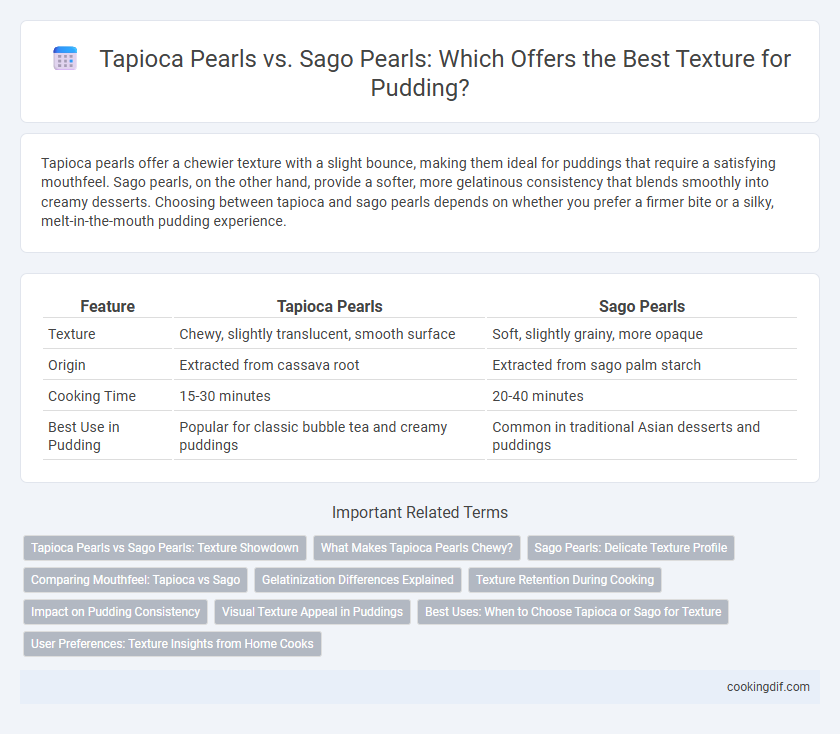Tapioca pearls offer a chewier texture with a slight bounce, making them ideal for puddings that require a satisfying mouthfeel. Sago pearls, on the other hand, provide a softer, more gelatinous consistency that blends smoothly into creamy desserts. Choosing between tapioca and sago pearls depends on whether you prefer a firmer bite or a silky, melt-in-the-mouth pudding experience.
Table of Comparison
| Feature | Tapioca Pearls | Sago Pearls |
|---|---|---|
| Texture | Chewy, slightly translucent, smooth surface | Soft, slightly grainy, more opaque |
| Origin | Extracted from cassava root | Extracted from sago palm starch |
| Cooking Time | 15-30 minutes | 20-40 minutes |
| Best Use in Pudding | Popular for classic bubble tea and creamy puddings | Common in traditional Asian desserts and puddings |
Tapioca Pearls vs Sago Pearls: Texture Showdown
Tapioca pearls offer a chewy, elastic texture that becomes pleasantly soft yet resilient when cooked, making them ideal for bubble teas and puddings. Sago pearls, derived from palm starch, provide a more gelatinous and slightly grainy texture, often resulting in a creamier but less bouncy mouthfeel. This textural distinction highlights tapioca pearls as the preferred choice for consumers seeking a springy bite, while sago pearls appeal to those who favor a smooth, melt-in-the-mouth consistency.
What Makes Tapioca Pearls Chewy?
Tapioca pearls owe their chewy texture to the high concentration of starch extracted from cassava root, which gelatinizes when cooked, creating a resilient and elastic bite. Unlike sago pearls, which are derived from palm starch and tend to be softer and more fragile, tapioca pearls maintain their chewiness even after prolonged cooking or soaking. This distinct gelatinized starch network in tapioca pearls provides the signature chewy consistency favored in puddings and bubble tea.
Sago Pearls: Delicate Texture Profile
Sago pearls offer a delicate and smooth texture that sets them apart from the more gelatinous and chewy tapioca pearls commonly used in pudding. Their smaller size and translucent appearance contribute to a subtle mouthfeel that melts gently on the palate. This refined texture makes sago pearls ideal for creating light, elegant puddings with a soft, silky consistency.
Comparing Mouthfeel: Tapioca vs Sago
Tapioca pearls provide a chewy, bouncy texture with a smooth and slightly gelatinous mouthfeel, making them popular in bubble tea and desserts. Sago pearls, derived from palm starch, offer a softer, more powdery bite that dissolves easily in the mouth, creating a lighter, less dense sensation. The distinct texture differences between tapioca's firmness and sago's delicate softness greatly influence their use in various pudding recipes.
Gelatinization Differences Explained
Tapioca pearls and sago pearls differ significantly in gelatinization, affecting pudding texture; tapioca pearls gelatinize at a lower temperature around 52degC, resulting in a chewy, translucent gel, while sago pearls require higher heat above 70degC, producing a more opaque and sticky consistency. The starch granules in tapioca swell uniformly, creating a smooth, elastic texture, whereas sago's granular structure leads to a less cohesive gel with a slightly granular mouthfeel. Understanding these gelatinization differences is essential for achieving desired pudding consistency and chewiness in culinary applications.
Texture Retention During Cooking
Tapioca pearls maintain a chewy, elastic texture even after extended cooking, making them ideal for puddings that require prolonged simmering. Sago pearls, by contrast, tend to become softer and more gelatinous, losing their firmness when cooked for too long. This difference in texture retention during cooking significantly influences the mouthfeel and consistency of tapioca versus sago-based puddings.
Impact on Pudding Consistency
Tapioca pearls create a chewy, slightly translucent texture that enhances pudding consistency by adding a soft, gel-like bite, perfect for smooth and creamy desserts. Sago pearls produce a more uniform, tender consistency that melts seamlessly into pudding, resulting in a lighter, silkier texture without overpowering the base. The choice between tapioca and sago directly affects pudding's mouthfeel, with tapioca lending more structure and sago contributing to a delicate, velvety finish.
Visual Texture Appeal in Puddings
Tapioca pearls create a translucent, glossy appearance in puddings, offering a smooth and slightly chewy texture that enhances visual appeal through their uniform sizes and subtle shine. Sago pearls, often more opaque and smaller, provide a softer, gelatinous texture with a matte finish that contrasts with pudding's creamy base. The choice between the two pearls significantly affects the pudding's tactile perception and overall aesthetic, with tapioca pearls emphasizing clarity and chewiness and sago pearls highlighting softness and subtle visual complexity.
Best Uses: When to Choose Tapioca or Sago for Texture
Tapioca pearls offer a chewy, translucent texture ideal for bubble tea and sweet puddings, providing a pleasant bounce and elasticity. Sago pearls, softer and more gelatinous, excel in delicate desserts and traditional puddings where a smoother, melt-in-the-mouth consistency is desired. Choose tapioca for robust texture in fusion drinks and sago for subtle, creamy applications in Southeast Asian desserts.
User Preferences: Texture Insights from Home Cooks
Tapioca pearls provide a chewy, bouncy texture that many home cooks prefer for puddings, offering a distinct mouthfeel that contrasts with the softer, more delicate consistency of sago pearls. Users often highlight tapioca's resilience during cooking, maintaining shape and firmness, while sago pearls tend to become more gelatinous and break down faster. Preferences vary based on desired pudding texture, with tapioca favored for a pronounced chewiness and sago chosen for a smoother, creamier experience.
Tapioca pearls vs Sago pearls for texture Infographic

 cookingdif.com
cookingdif.com